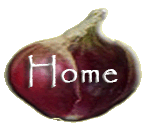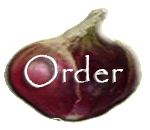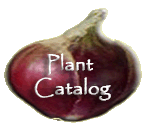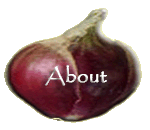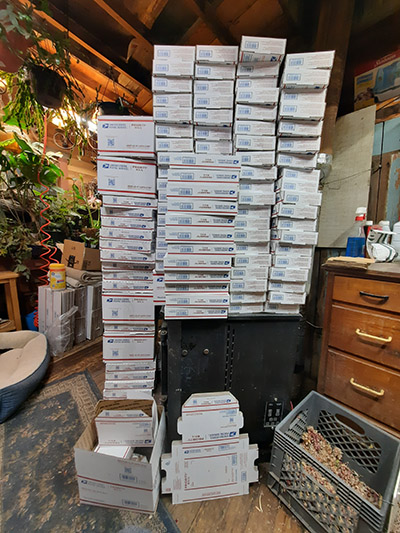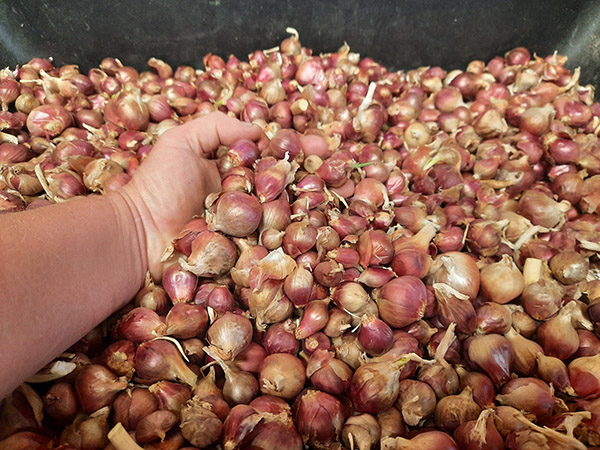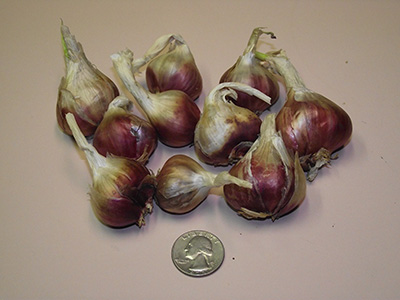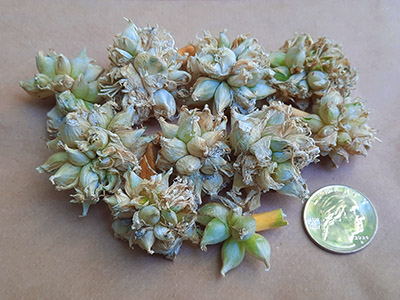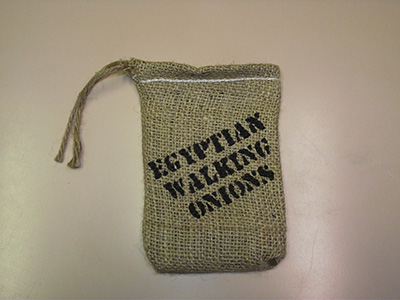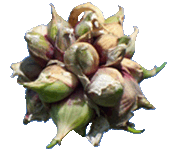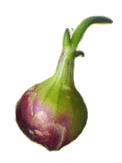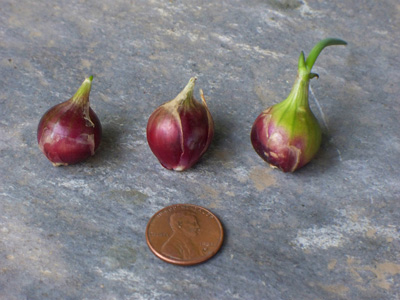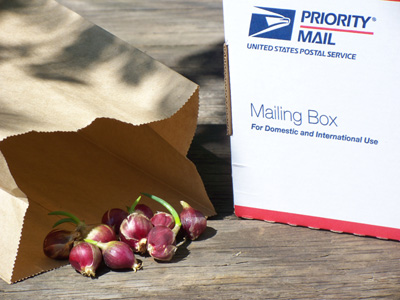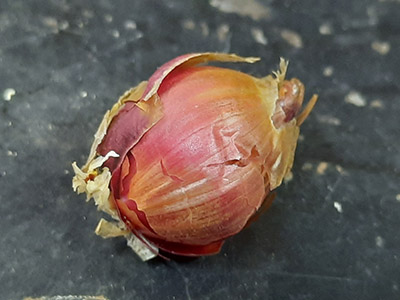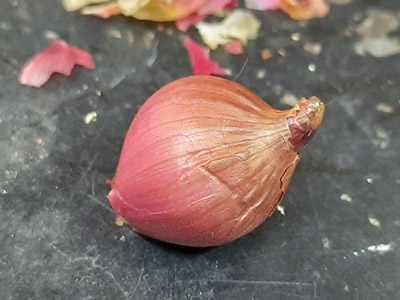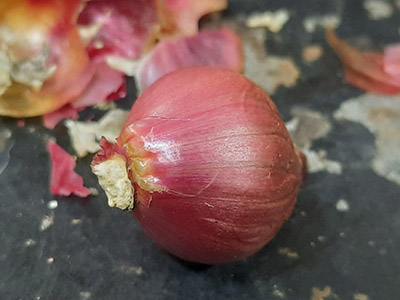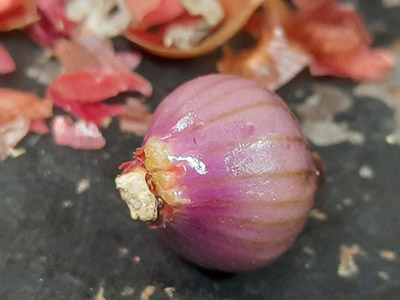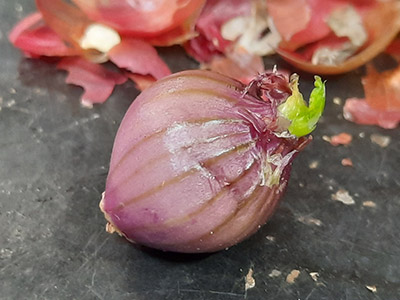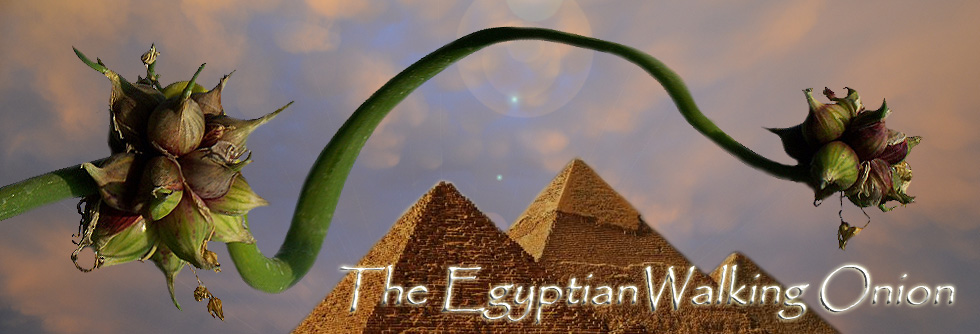
|
Buy
Your and White Topsets Scroll down to buy onions!
Don't
miss out on adding Egyptian Walking Onions to your fall planting
line up! We send FREE extra topsets with every counted topset order to assure happy onioning! We have not raised our prices on counted topsets in over 10 years! WOW! We are willing to buy LARGE amounts of Egyptian Walking Onions! We are open for trades! looking for rare (uncommon, hard to find), cold hardy (zone 5ish) berry plants/cuttings. Including: currants, gooseberries, honeyberries (Lonicera), thornless blackberries, elderberries, aronia berries, autumn olive, seaberries, bayberries, some raspberries, and anything variegated. We are also looking for the elusive Quercus macranthera oak tree, commonly known as the Persian Oak or Caucasion Oak, and Salix (willow) species used for basket weaving or ornamental purposes. We are open for trading your plants/cuttings for our Egptian Walking Onion topsets, or our various plants/cuttings. Thank you! Sorry, we cannot ship outside the United States Our Egyptian
Walking Onions are organic and non GMO! Please
scroll down and read the "Topset Ordering and Shipping Information"
Meanwhile.....I will be counting and packaging your topsets! Anyone
who thinks that gardening begins in the spring and ends in the
fall
"The
rain to the wind said, |
|||||||||
|
Items
marked "Now Shipping" will ship immediately. |
|||||||||
| SPECIAL! WHITE Egyptian Walking Onion Spring Starter Plants! | |||||||||
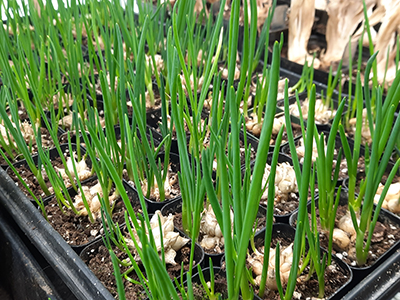 |
Egyptian Walking Onion spring starter plants! Plants are baby white topset clusters potted up in a 2" square pot. Suggested planting is to remove plant clump from pot, and plant the whole thing directly into the ground. Do not separate the plants. If planting in the direct sun, lightly shade for the first week or two (plastic milk jug (lid off) works great) because these plants are greenhouse grown. Keep soil moist. In the fall, when the bulbs are bigger, you can divide them into individual plants. Topsets will be at varying stages of growth when shipped. Leaves may be cut back for shipping purposes.
$9.99
for one pot of plants |
||||||||
|
|
|||||||||
| SPECIAL! RED Egyptian Walking Onion Spring Starter Plants! | |||||||||
 |
Egyptian Walking Onion spring starter plants! Plants are baby RED topset clusters potted up in a 2" square pot. Suggested planting is to remove plant clump from pot, and plant the whole thing directly into the ground. Do not separate the plants. If planting in the direct sun, lightly shade for the first week or two (plastic milk jug (lid off) works great) because these plants are greenhouse grown. Keep soil moist. In the fall, when the bulbs are bigger, you can divide them into individual plants. Topsets will be at varying stages of growth when shipped. Leaves may be cut back for shipping purposes.
$9.99
for one pot of plants |
||||||||
|
|
|||||||||
| SPECIAL! Red Egyptian Walking Onion Ground Bulbs | |||||||||
 |
We are now offering red Egyptian Walking Onion ground bulbs for a limited time only, and there is a very limited number of these available. They are currently dormant bulbs and ready for panting. Just plant them in your perennial garden or pot. Depth to plant: the soil should be about halfway up the bulb. Plant your bulbs now and they will produce topsets and ground divisions next summer. Size varies from about 1-2 inches long. As always, we send extra bulbs. $9.49
for 3 bulbs |
||||||||
|
|
|||||||||
| Boxfull of Red Mini Topset Clusters | |||||||||
|
|
Boxfulll of minitature red topsets = lots of plants for a great price! Although small, these miniature topset clusters will produce many Eygptian Walking Onion plants which will eventually mature into full size plants and produce topsets of their own. Each cluster averages about 20 tiny topsets. Some clusters are partial (in pieces) and do not form a complete round ball. More of these will be added to your order to make a "complete" cluster. You will receive well over 100 tiny topsets per order! Break apart the clusters into individual topsets and plant 1-2" below the soil, or plant the whole cluster! Water and watch it grow! Quarter is for size reference.
$14.49
for a small flat rate boxfull of red minitaure clusters
Now
Shipping! |
||||||||
|
|
|||||||||
|
PRESALE
ITEMS - order now for fall shipping
|
|||||||||
| 10 Red Topsets | |||||||||
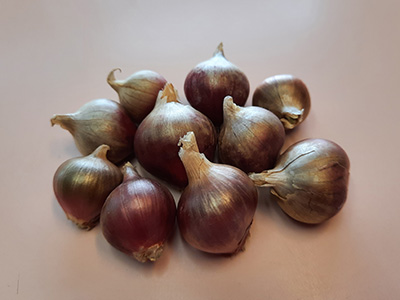 |
Our "counted" topsets are avarage sized topsets as shown in the photo. If you have a small garden, pots on a balcony, or just want to give this plant a try, then 10 topsets is probably the right choice for you. Plant 2" deep and 6" to 12" apart. $7.00
for 10 red topsets |
||||||||
|
To plant a garden is to belive in tomorrow. -Audrey Hepburn |
|||||||||
| 25 Red Topsets | |||||||||
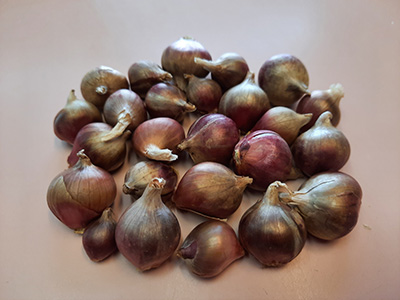 |
25 Topsets: our best seller! Twenty-five will give you a decent sized Egyptian Walking Onion patch or row. Plant about 2" deep and 6" to 12" apart. Remember, the bulbs in the ground also divide, so eventually you will need to thin them out. $15.00
for 25 red topsets |
||||||||
|
|
|||||||||
| 25 White Topsets | |||||||||
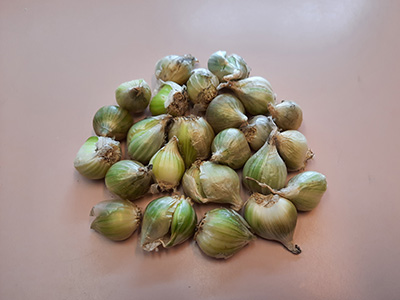 |
Here they are! The long sought after White Topsets! Well, they're kind of greenish-white, but they call 'em white. White topsets are generally smaller than red topsets. 25 White Topsets: our best seller! Twenty-five will give you a decent sized Egyptian Walking Onion patch or row. Plant about 2" deep and 6" to 12" apart. Remember, the bulbs in the ground also divide, so eventually you will need to thin them out. $15.00
for 25 red topsets |
||||||||
|
|
|||||||||
| 25 Red + 25 WhiteTopsets | |||||||||
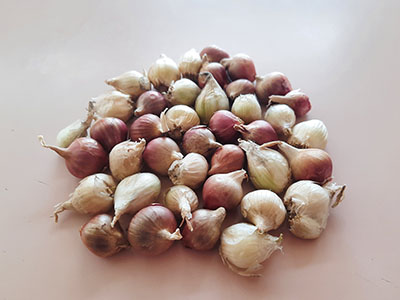 |
Not sure which color to get? Try them both! Get 25 red topsets and 25 white topsets - a total of 50 topsets! White topsets are generally smaller than red topsets. $30.00
for 25 red and 25 white topsets Sold Out |
||||||||
|
|
|||||||||
|
“And
why do you worry about clothes? See how the flowers of the field
grow.
They do not labor or spin. Yet I tell you that not even Solomon in all his splendor was dressed like one of these.” – Matthew 6:28-29 |
|||||||||
|
|
|||||||||
| 50 Red Topsets | |||||||||
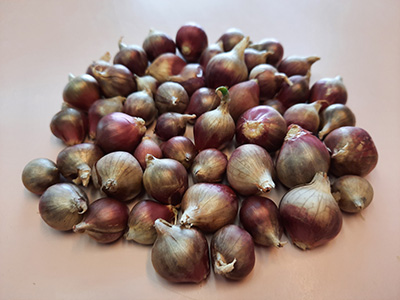 |
50 Topsets: now we're getting serious! This amount of topsets is for the onion lover! You will have a great supply of greens, bulbs, and topsets. You may want to consider dedicating a perennial garden just for these little babies! Plant 2" deep and 6" to 12" apart. You can plant them closer together, but you will have to thin them out sooner. $25.00
for 50 red topsets |
||||||||
|
|
|||||||||
| 50 WhiteTopsets | |||||||||
 |
Here they are! The long sought after White Topsets! Well, they're kind of greenish-white, but they call 'em white. White topsets are generally smaller than red topsets. 50 Topsets: now we're getting serious! This amount of topsets is for the onion lover! You will have a great supply of greens, bulbs, and topsets. You may want to consider dedicating a perennial garden just for these little babies! Plant 2" deep and 6" to 12" apart. You can plant them closer together, but you will have to thin them out sooner. $25.00
for 50 white topsets Not
offered this year due to limited quantity |
||||||||
|
|
|||||||||
| 50 Red + 50 WhiteTopsets | |||||||||
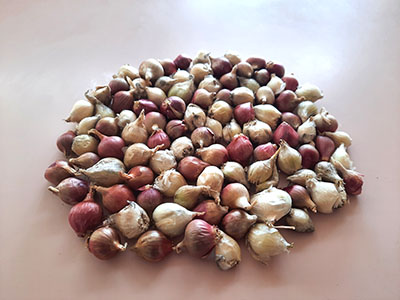 |
Not sure which color to get? Try them both! Get 50 red topsets and 50 white topsets - a total of 100 topsets! White topsets are generally smaller than red topsets. $50.00
for 50 red and 50 white topsets |
||||||||
|
|
|||||||||
|
“Again
he said, ‘What shall we say the kingdom of God is like,
or what parable shall we use to describe it? It is like a mustard seed, which is the smallest of all seeds on earth. Yet when planted, it grows and becomes the largest of all garden plants, with such big branches that the birds can perch in its shade.’” – Mark 4:30-32 |
|||||||||
|
|
|||||||||
| 100 RedTopsets | |||||||||
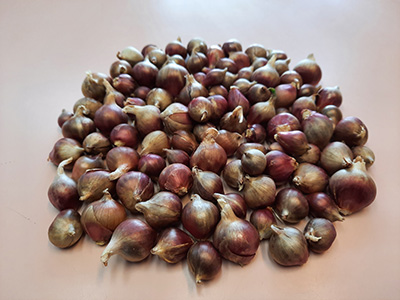 |
100 Topsets: for the expert gardener who loves their onions and wants to start out with a good sized Egyptian Walking Onion patch. Here's a visual: if you plant these at 1 foot apart, you would have a 10'x10' Egyptian Walking Onion garden. $40.00
for 100 red topsets |
||||||||
|
"I
frequently tramped eight or ten miles through the deepest snow - Henry David Thoreau |
|||||||||
| 200 Red Topsets | |||||||||
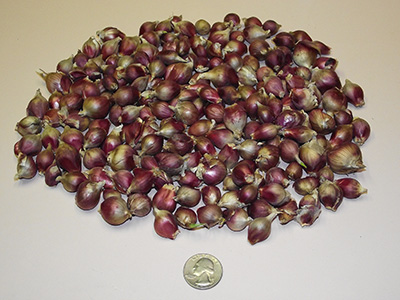 |
200 Topsets: this is a lot of topsets, but maybe you want a lot of onions - a lifetime supply of them coming back every year for you and your family, neighbors, and friends! If you pant these in rows 6" apart, you will have four 25 foot rows of Egyptian Walking Onions. $60.00
for 200 red topsets PRE-SALE |
||||||||
|
|
|||||||||
| 500 Red Topsets | |||||||||
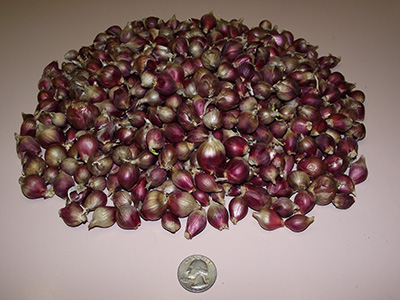 |
500 Topsets: now I'm thinking about permaculturists and homesteaders....maybe even nurseries. This is our wholesale price. It's a good price for A LOT of plants!! Need more than 500 topsets? Just send me an email with your request: tracy@starsunmoon.com $125.00
for 500 red topsets
|
||||||||
|
To
make a prairie it takes a clover and one bee, - Emily Dickinson |
|||||||||
| 10 Red JUMBO Topsets | |||||||||
|
|
Jump
start your onion patch! This is a good choice if you want immediate
results when planting topsets. These sets are nice and big, and are
very similar to what the mature bulbs in the ground are like. They
will make nice big plants their first year, and will more than likely
even produce tiny topsets.
JUMBO topsets are at least one inch or more in diameter. We only have a limited supply, so get them now before they are gone. Quarter is for size reference.
$25.00
for 10 red jumbo topsets
|
||||||||
|
|
|||||||||
|
|
|||||||||
| Boxfull of White Mini Topset Clusters | |||||||||
|
|
Boxfull of minitature white topsets = lots of plants for a great price! Although small, these miniature topset clusters will produce many Eygptian Walking Onion plants which will eventually mature into full size plants and produce topsets of their own. Each cluster averages about 20 tiny topsets. Some clusters are partial (in pieces) and do not form a complete round ball. More of these will be added to your order to make a "complete" cluster. You will receive well over 100 tiny topsets per order! Break apart the clusters into individual topsets and plant 1-2" below the soil, or plant the whole cluster! Water and watch it grow! Quarter is for size reference.
$14.49
for
a small flat rate boxfull of red minitaure clusters |
||||||||
|
|
|||||||||
|
“And
forget not that the earth delights to feel your bare feet — Khalil Gibran, The Prophet |
|||||||||
|
|
|||||||||
| Onion Sack | |||||||||
|
|
Give
the gift of onions! The Onion Sack is a miniature burlap sack with
a drawstring. This cute little Onion Sack makes a perfect little
gift bag for your Egyptian Walking Onion topsets! Each sack is stamped
(it's actually hand painted with fabric ink) "EGYPTIAN WALKING
ONIONS" in messy stencil font, and measures 4" x 6."
One sack can hold up to 50 average sized Egyptian Walking Onion
topsets.
|
||||||||
|
Delicious
autumn!
|
|||||||||
|
Topset Ordering and Shipping Information Please
read this section before placing an order for Egyptian Walking
Onion topsets. Our
Egyptian Walking Onion topsets are sold in batches of 10, 25,
50, 100, 200 and 500. Still not sure what to order? I get asked the following question quite often: how many topsets should I order? Well, it all depends on what you want to do with your onions, and how big of an "onion patch" you want. Most people are looking forward to eating the onions, and I'm talking about the bulbs in the ground. Therefore, you need to have enough bulbs so that you can harvest some to eat, and also leave some growing in the ground. The ones you leave in the ground will be your 'supply' bulbs. Your supply bulbs will divide in the ground and make more bulbs which you can eat and plant. In the summer you can harvest your onions to eat. In the fall you can dig up your supply bulbs, separate them, and replant them for onions to eat next year. When you plant the onion bulbs that you plan to eat, give them enough space so the bulb has room to grow as big as it can. A plant every six inches is enough. The trick to getting the bulb to grow bigger is to cut off the topset stalk in the spring. The topset stalk appears during the 'candlestick' phase (see home page for more about this.) When you see it, just cut it off so that the plant does not start producing topsets. This will allow the plant to focus its energy on the bulb in the ground. This is the same process used for growing garlic. With a garlic plant, the scape is cut off in order to grow a bigger bulb of garlic cloves in the ground. If the scape is left to grow on the garlic plant, it will produce little bulbils (mini topsets) just like an Egyptian Walking Onion plant! So now you may be thinking: but what if I want to grow the topsets? Well, you can let them grow on your 'supply' bulbs, not your 'eating' bulbs. Just let your supply bulbs grow as they will. They will divide in the ground and also produce topsets which you can eat, plant, or share with your neighbors! Remember, when you plant the topsets, they will not produce topsets of their own until the second season. What is a topset? An Egyptian Walking Onion "topset" is one of the little "bulblets" that grows in a cluster at the top of the plant. It is essentially a baby Egyptian Walking Onion plant. Below is a comparison of a cluster of topsets and just one topset.
Topset size: Topsets are marble sized. The majority of our topsets range from approximately 1/4" to 3/4" in diameter, however, some may be bigger and some may be smaller. Any order of Egyptian Walking Onion topsets may contain sets that fall in the extreme small or large end of this size range. Meaning, when you order 10 topsets, you may get "big" topsets that are 1" or more in diameter, and you may get "small" topsets that are 1/4" or less in diameter. We deal with thousands of topsets, so the sets you receive are the luck of the draw. However, we do try to send a fair range in size so that you don't receive all small or all large topsets. We strive to grow exceptional topsets that are nice and big. Our average topset size has gotten bigger over the years. We sell most of the smaller topsets as "balled and burlapped topset plants." As always, we do send extra topsets with every order.
Topset shape and appearance: The shape of an Egyptian Walking Onion topset varies. Some topsets are round, and some are enlongated. Some are even flat! Most all topsets will have a little sprout or roots emerging. Some topsets may have greens up to 3 or 4 inches long. Topset colors range from green to reddish/purple. The outer layers of your topsets will be dry. This is normal and occurs during the curing process. Dry outer layers protect the topsets from excessive moisture loss and entrance of pathological organisms such as mold and bacteria. What
you will receive: When an order is placed, the Egyptian Walking Onion topsets are carefully picked by hand and counted. We always throw in a few extra for positive onion energy! The topsets are placed into a small paper bag (lunch bag), which is then put into a small US Priority mail box. We do not send any planting instructions or other printed material with your order, except maybe a business card. We are striving to be a "green" company so we try to conserve when possible. Since we post general planting directions on our website, we can save paper and ink by not printing and sending them. Thank you for your understanding. An
example of an order of Egyptian Walking Onion topsets. What to do with your topsets when they arrive: Onion
sets do not store very well. They are not like a seed with a hard
outer coating that protects them from extreme environmental conditions.
Egyptian Walking Onion topsets are in fact miniature plants. They
are very vulnerable and can dry out, mold, or even die if not cared
for properly. We continue to sell our Egyptian Walking Onion topsets
through the winter, long after they have been harvested. This is
because we cure them before putting them in storage. We store them
in a cold, dark place all winter at whatever the outdoor temperature
happens to be. The colder, the better! They can remain viable for
over 6 months this way, but they would do far better if they were
planted in the ground. We recommend that you plant your Egyptian
Walking Onion topsets as soon as possible after you receive them.
If the ground is frozen or covered with snow when you get your topsets,
just plant them in a pot of soil and keep them inside. Keep the
pot in a cool, dark place if you don't want them to grow too much.
Put the pot in a warm, sunny place if you want them to grow like
crazy. Do not over water them. Once per week is good. Make sure
the water drains through the soil well. There are more planting
instructions on the home page. Topset Viability: Our topsets are harvested in August. After they are harvested, we cure them in our onion shed. They are spread out on fine wire mesh racks so there is plenty of air flow around them. It is also fairly dark. The topsets may have green leaves and even roots when we harvest them, but as they cure in the shed, the leaves and roots dry out and shrivel up. The outer layers of onion skin that are wraped around the topsets become dry and crispy. These layers are called "tunics" and serve to protect the topset from injury, infection, and dehydration. After about two or three weeks, the topsets are "cured" and induced into a dormant state. They will remain dormant until they are planted in the ground. As the weeks and months go by for the topsets in storage, the outer layers will continue to dry and become crispy. The outermost layers will eventually fall off as new layers underneath crisp up. This process is similar for all tunicate bulbs. The dry, papery outer layers lead some people to believe that their topsets may not be viable because they think the topsets may have become dehydrated and dried out. Dry outer layers do not mean that your topsets are not viable. It does not mean that they are dried out and dehydrated. They are simply dormant and the dry outer layers are there for protection against damage, mold, bacteria, and dehydration. It is perfectly normal and natural. Alliums (onions and garlic) use this method to protect their "bulbs" as well as tulips, daffodils, hyacinths, and grape hyacinths (muscari). Here
are some things you can look for to check for viability:
If
your topsets are squishy when you squeeze them and they collapse
in quite a ways, then they may not be viable. If you are in doubt,
peel back the outer layers. If you see black mold on the inside
layers, and the flesh is soft, brown, and watery, you may be able
to save your topset. Peel off all the rotten layers until you find
a clean live layer. Let the topset cure for two weeks. The outermost
layer will dry up and form a tunic. Then try planting it. Wholesale: Please contact us for wholesale prices on large quantities. Our Egyptian Walking Onion topsets are not sold by the pound or by size, we sell by count only. Ask us about our discounts for schools and nonprofit organizations :-) Payment: If you do not want to pay over the internet, you can pay with a check or money order payable to "Tracy Paine." Include a note as to what you would like to order. Send it to: Tracy Paine 301 S 10th St., Garfield, WA 99130. Shipping: We
ship USPS Priority mail. Another
Poem About Egyptian Walking Onions In
gardens of old, they grew tall and green, Their
name may sound strange, but their magic is true, Their
flavor is bold, with a hint of spice, So
if you have a garden, and a taste for the unique,
Thank
you for your order!
|
|||||||||
